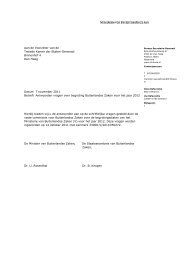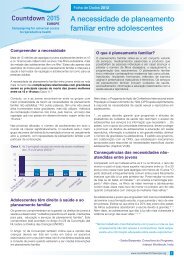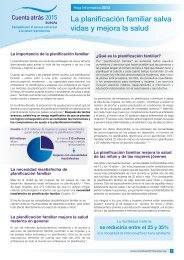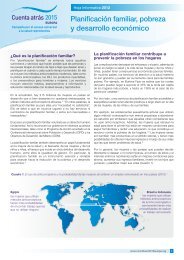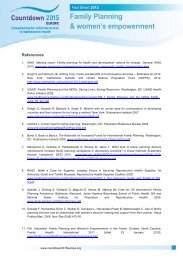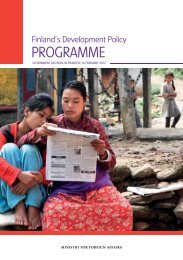The Unmet Need for Family Planning - Countdown 2015 Europe
The Unmet Need for Family Planning - Countdown 2015 Europe
The Unmet Need for Family Planning - Countdown 2015 Europe
Create successful ePaper yourself
Turn your PDF publications into a flip-book with our unique Google optimized e-Paper software.
Taking a rights-based approachParaguay••In just six years, the use of modern contraceptive methodsincreased dramatically, from 48% to 61% percent throughoutParaguay, and from 41% to 55% in rural areas.••<strong>The</strong>re was a particularly significant increase in the use ofmodern contraceptives <strong>for</strong> the youngest and oldest marriedwomen – the groups with the highest rates of maternalmorbidity and mortality and adverse pregnancy outcomes.<strong>The</strong>se changes have been attributed in part to the introduction ofa constitutional protection guaranteeing every individual the rightto decide the number and spacing of their children. <strong>The</strong>re wasstrong political commitment to implement this right, includingearmarking funds <strong>for</strong> contraceptive commodities, and private–public partnerships. Combined with initial donor support, this ledto an expansion of contraceptive services and a wide range ofcontraceptive choices (USAID/DELIVER 2006).GuatemalaIn 2005, Guatemala passed legislation to ensure universal access toall contraceptive methods. Despite multiple legal challenges, the lawwent into effect in October 2009. <strong>The</strong> Universal and Equitable Accessto <strong>Family</strong> <strong>Planning</strong> Services Law establishes the goal of achievinguniversal access to modern contraceptives throughout the countryand includes strategies <strong>for</strong> addressing various barriers to access. Inaddition to guaranteeing access to contraceptive methods, the lawincludes provisions that ensure free and in<strong>for</strong>med decision-making,adequate contraceptive in<strong>for</strong>mation and counselling, providertraining, and sexuality education in both primary and secondaryschools. To help meet these goals, the law incorporates elements of ahuman rights-based approach. For example, it focuses on vulnerablegroups, including adolescents and individuals living in rural areas,who lack access to basic health services. Additionally, the law calls<strong>for</strong> national surveys to identify the unmet need <strong>for</strong> family planning andrecommends the development of tools <strong>for</strong> monitoring the provision ofcontraceptive services and evaluating progress in removing barriersto access (Center <strong>for</strong> Reproductive Rights/UNFPA 2010).ColombiaDespite opposition from the Catholic Church, the Colombiangovernment worked with civil society to support reproductivehealth services, including access to contraceptives. This jointwork led to an increase in contraceptive use among marriedwomen from 20% in 1969 to 66% in 1990. <strong>The</strong> unmet need<strong>for</strong> contraception fell as low as 11%, and maternal mortalitydropped from more than 240 deaths per 100,000 live births toan estimated 120 deaths per 100,000 live births in 1990.In 1991 the country’s new constitution recognized health as a basicright and led to significant health re<strong>for</strong>ms, such as establishinguniversal health insurance that included family planning coverage.Since then the unmet need has dropped even further to 6%, andcontraceptive use has increased to 78% among married women.In 2010, a constitutional court decision led to further improvementsin the health insurance benefits package <strong>for</strong> family planning (Singh,Darroch et al. 2009).<strong>Family</strong> planning successesIndonesia<strong>The</strong> average number of children Indonesian women had duringtheir lifetimes in the 1960s was six per woman, and at least twoof these six children were expected to die be<strong>for</strong>e reaching schoolage. In response, the government launched its family planningprogramme in 1967, with an emphasis on spacing children anda focus on community participation and encouraging couplesto think about how, whether and when to have children. Thishelped to strengthen perceptions that smaller families wereacceptable and desirable. Now figures show that families haveabout 2.6 children per couple, and more than 60% of marriedcouples practise birth spacing, most through the use of moderncontraceptives (USAID).Togo<strong>Unmet</strong> need <strong>for</strong> family planning remains high in Togo, where theproportion of women of reproductive age who are using (or whosepartner is using) a modern contraceptive method at a given pointin time is only about 9%. This problem has been compounded bycuts in donor funding <strong>for</strong> contraceptive commodities.To improve access to contraceptives, the Ministry of Health, incollaboration with multiple stakeholders including the Ministryof Finance, launched a strategic planning process in February2004. <strong>The</strong> Ministry of Health advocated with the Ministryof Finance to create a budget line item <strong>for</strong> contraceptivecommodities. Be<strong>for</strong>e the strategy was finalized in September2005, the Ministry of Finance recognized the significance of theresource gap and declared its intention to create a line-item <strong>for</strong>contraceptive purchases and in the interim, allocated CFA50million (US$95,000) to the Ministry of Health <strong>for</strong> the purchase ofcontraceptives (RHSC 2009).www.countdown<strong>2015</strong>europe.org29




